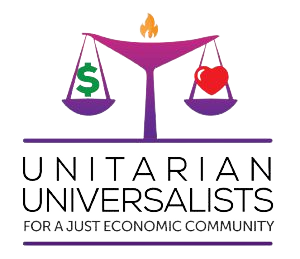We are a gentle, angry people. Holly Near
We collated a list of hymns that celebrate working people and economic justice in the 21st century. The hymns noted below are included in the hymnbook Singing the Living Tradition. All of the hymns are appropriate for Labor Day gatherings and other events that bring different groups together. Some of the the songs are classics; others have been developed to support labor and community organizing in today’s world.
- Dear Weaver of Our Lives’ Design (Hymn 22)
Feminist imagery for working people. - As We Come Marching, Marching (Hymn 109)
The legendary “Bread and Roses” song. Helen Todd, a factory inspector and a women’s rights activist, may have been the first person to use the slogan bread and roses. During the early 1900s, labor unions were often identified with worker demands for higher wages. Pay increases are often needed, but activists like Helen Todd spoke about the need for fair wages and dignified working conditions. Her words in 1911 inspired a poem by James Oppenheim. According to some reports, the slogan “Bread and Roses” appeared on banners that were carried by girls during the 1912 textile strike in Lawrence, Massachusetts. Child labor was commonplace in American factories, farm fields, and mines during the early 1900s. Displays of bread and roses are appropriate for Labor Day and other holidays that celebrate economic justice. The bread basket can include bagels, cornbread, tortillas, rice cakes, and other foods to acknowledge cultural diversity. After the celebration, neighbors can break bread together.. It’s an old tradition. - I’m On My Way (Hymn 116)
African-American folk hymn. An Underground Railroad song that encourages people to escape from slavery. The Underground Railroad developed with the support of some Universalists, Unitarians, Quakers, and other people of faith and good will, during the decades before the American Civil War. - This Little Light of Mine (Hymn 118)
The origin of the hymn is unclear, but it was popular with the civil rights movement during the 1960s and it has often been sung at labor union gatherings. Easy to learn and sing. Impromptu verses are often added, to be used during marches and on picket lines. - We’ll Build a Land (Hymn 121)
Inspired by the words of the prophets Amos and Isaiah in the Bible. Those of us in the United States, on whose land is our land built? - Our World is One World (Hymn 134)
A reminder that we live in a global economy. - Step by Step the Longest March (Hymn 157)
This hymn can be sung as a musical round. Music arranged and adapted by Waldemar Hille and Pete Seeger. The hymn is an unofficial anthem for the United Mine Workers of America. In today’s America, the United Mine Workers represents active coal miners, and it also represents many healthcare workers, transportation workers, and working people in other industries. - We Are a Gentle, Angry People (Hymn 170)
A Holly Near song appropriate for the new Labor Day events. - Hosanna in the Highest (Hymn 262) This hymn has been used during Christmas Eve services, Palm Sunday processions, and other Unitarian Universalist events that honor Jesus of Nazareth. Jesus, who for many religious liberals, was “the first of many prophets who come of simple folk.” “When another spirit spirit arises from the plain, the courts of power tremble and crucify again.” See also O Young and Fearless Prophet (Hymn 276)
- De Colores (Hymn 305) A Spanish folk song that is identified with farm-worker unions in the United States. The rainbow imagery is popular with Unitarian Universalists. “Las Voces del Camino” is a Unitarian Universalist hymnbook that includes 75 hymns in Spanish.
